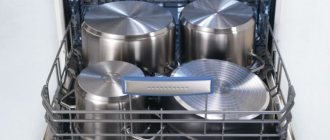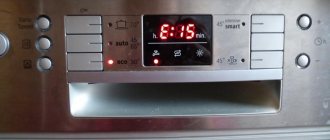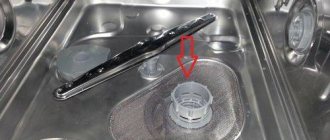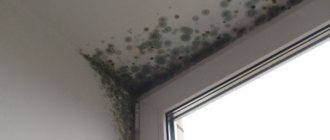The first mechanized dishwasher went on sale in 1886. American Josephine Cochrane said to herself “I am a woman, not a dishwasher!” (more precisely: “If nobody else is going to invent a dishwashing machine, I'll do it myself!”) and invented the dishwasher.
In the 1950s, compact dishwashers suitable for home use began to be sold. Since then, this household appliance has been a typical “resident” in American kitchens, along with a refrigerator or coffee maker.
In our country, dishwashers have long been considered an unaffordable luxury. But in recent years, more and more people are realizing their advantages (saving time, quality of washing).
From this article you will learn how to properly wash dishes in a dishwasher, as well as what to do to ensure that the appliance serves you for many years.
Dishwashers come in floor-standing (free-standing or built-in) and countertop (compact) types. Floor-standing dishwashers are also divided into “narrow” (45 cm wide, for 9-13 sets) and “full-size” (60 cm wide, for 7-16 sets).
A set is a set of dishes for one person (tureen, flat plate, saucer, mug, cutlery).
In addition, dishwashers differ in operating modes, type of load, efficiency of water and electricity consumption and other parameters.
But regardless of the brand of dishwasher, there are general rules for its operation. Let's get acquainted with the main ones.
Rule No. 1 – Place dishes inside the machine correctly
As a rule, modern dishwashers are equipped with 2 baskets for loading dishes. The lower one is intended for large items (pots, pans, large dishes). The top one is for tableware (plates, cups, etc.). Spoons, forks, knives and other cutlery are usually placed in a special tray that comes with the machine or is sold separately.
To optimally place dishes inside the machine, start loading from the lower basket. Place large plates on the edges, small ones closer to the center. There, in the middle, place a tray with cutlery (if there is none, still put the forks and spoons in the center).
The dishes should not interfere with the rotation of the machine's rocker arms. Therefore, do not place pans and other items with long handles vertically.
Water in the dishwasher is usually supplied from the bottom up, so place hollow items (mugs, plates, cups) upside down. Do not lay them on their sides - water and detergent will remain. In addition, it is not recommended to stack objects on top of each other.
Do not overload the machine. And if the dishes are very dirty, then it is better to place the plates not in each cell of the basket, but every other.
But the most important thing to remember is which dishes can be washed in the dishwasher and which cannot.
What should not be washed in the dishwasher:
- old cracked or glued dishes;
- wooden objects (cutting boards, knives with wooden handles, etc.);
- objects made of rusting steel, copper and tin;
- non-heat-resistant dishes (glass and plastic).
What is not recommended for washing in the dishwasher:
- silver and aluminum items (or only using special detergents and washing programs);
- crystal dishes (or only with special products and gentle washing modes);
- earthenware (if the detergent and washing program are selected incorrectly, the glaze and designs may fade).
At the end of the wash cycle, wait 10-15 minutes for the dishes to cool. If you take out the dishes right away, you can get burned. In addition, hot dishes break more easily.
Do not use the dishwasher as a washing machine. Do not wash kitchen towels, sponges or other utensils in it.
List of what you will need
To combat foam, there are products that everyone will probably have in their home:
- Distilled white vinegar.
- Olive oil or any other vegetable oil.
- Salt.
- Bowl or small bucket, container.
- Several dry towels.
- Liquid fabric conditioner.
- Defoamer Spa.
They are not used by everyone at the same time, but only when necessary. Choose the one that suits you best and take action.
Rule No. 2 – choose the right washing mode
A standard dishwasher cycle includes pre-wash (rinsing off food residues with cold water), wash (directly washing with hot water using detergent), rinse (rinsing off detergent) and drying.
In addition, in dishwashers there are such programs as intensive washing (very high tº - up to 75 degrees), a program for fragile dishes (water tº - from 30 to 40 degrees), quick wash (when you need to rinse the dishes after liquid food and immediately after meals) and others.
The program you choose (washing time and temperature) must correspond to the type of dishes and the degree of soiling.
In addition, dishwashers of the middle and highest price categories have a “pre-soak” function. But it is much easier and more economical to manually clean off dried-on food residues from them before loading the plates into the machine. The same thing with “burnt” pots and pans.
Ice
If the dishwashing cycle has been set to hot, the hot water will likely cause soap scum to grow. Ice will help correct the situation.
Just add ice cubes to the foam, preferably more. Mixing them with plenty of table salt may also help.
Rule #3 – Use the right detergents
Dishwashers use special detergents.
Do not use regular dishwashing gels and powders.
Dishwasher detergents can be divided into two types - powder and tablets.
Powders are more common. On average, its consumption per 1 dishwasher cycle is 25-30 grams.
Tablets are considered more convenient. They are single-layer, multi-layer and combined. The latter are considered the most practical, as they combine detergent components, rinse aid and regenerating salt. If your car model allows for the use of such products, you will not have to buy three different substances.
The consumption of tablets is approximately 1 tablet per 1 cycle.
It is not recommended to use tablet detergents in gentle washing programs - the tablet does not have time to dissolve.
Based on their properties, dishwashing detergents can be divided into strongly alkaline and weakly alkaline (usually with enzymes). Enzymes are biological enzyme additives that break down proteins, fats and polysaccharides that make up contaminants. Enzyme products are usually used to wash fragile dishes.
Bigger doesn't mean cleaner. Use as much detergent as directed in the instructions.
In addition, unless there are special instructions on the packaging, you should not wash fragile or silverware with it.
In addition to detergent, to use your dishwasher effectively, you need rinse aid. It removes detergent residue, adds shine to dishes and helps them dry quickly. Rinse aid consumption is approximately 0.5-0.7 liters for 10-12 cycles.
Salt
Sprinkle a layer of table salt on top of the soap suds. You can also mix salt and vinegar (1 cup and about 2 tablespoons salt). Pour the resulting solution onto the soap suds or into the bottom of the dishwasher. Select the normal cycle and run the dishwasher for a few minutes. If the soap suds do not go away, repeat the operation.
If you are using only table salt, sprinkle a generous amount on top of the soap suds. Salt breaks it down and acts as an antifoam, preventing its formation.
If soap scum is still rising, add more salt and run the dishwasher again. Repeat the process until it is all gone.
Rule No. 4 – watch the water hardness
The cleanliness of dishes washed in the dishwasher also depends on the hardness of the water. Hard water leaves white streaks on dishes.
In most cases, water softening is required for the machine to function properly. For this, regenerating salt is used. Usually the capacity for it in cars is quite large - 1-2 kg. It lasts long enough.
In addition, lime from hard water settles on the heating elements of the machine, which can cause damage. Therefore, salt is also necessary to protect the device.
Vinegar
Pour a glass of vinegar directly into the bottom of the dishwasher. Start pouring a little at a time, half the volume is enough to start.
Run the dishwasher on normal cycle for a few minutes. Make sure the soap suds begin to dissolve. If not, pour another 1/2 cup and press start again.
If this does not help, add another cup of vinegar and repeat the operation. Or try another way.
Rule #5 – Take care of your dishwasher
Any technique loves care. Dishwashers are no exception. If you want your machine to serve you for a long time, follow these recommendations.
Clean the filter from time to time (washed-out food residues settle on it). Also wash the dish baskets regularly (they are usually easy to remove).
Use additional dishwasher care products. So, every 15-20 cycles it is recommended to use a degreaser (powder or gel product). It helps remove accumulated grease from the inside of the machine.
Also, give your car “prevention” 2-4 times a year. To do this, you can use a special product or regular citric acid. Pour anti-scale into the dispenser and turn on the unloaded machine on a standard cycle.
Finally, at least once a week, wipe the dishwasher with a damp cloth, inside and out, not forgetting the door seal.
Preparing for work
Buying a dishwasher does not mean that you can use it to immediately start washing dishes by connecting several hoses to the water supply and sewerage system. Before using your dishwasher, you should perform two important operations - proper installation and test washing.
A specialist can install the equipment, but if for some reason this is not possible, you can use simple instructions:
- Place the equipment in the place provided for it. The equipment can be built in completely, like the Electrolux EES 948300 L, and partially, like the BBK 60-DW203D. Or installed separately, like Weissgauff TDW 4017 D.
- Connect the dishwasher to cold and hot water supply - using inlet hoses, tees or manifolds. Although, due to the low quality of hot water supply, it is worth connecting the machine only to a regular water supply. In this case, the water is heated by built-in heating elements.
- Connect the dishwasher to the sewer pipe through a tee or siphon.
- Plug the machine's power cord into a power outlet. It is advisable that the line be equipped with a separate RCD circuit breaker.
Before the first start, a dry wash should be performed, without dishes. Its task is to remove dust, dirt and grease residues from the inner surface. The process involves the use of detergent powder, but does not require rinse aid, for which you can add a small amount of water to the compartment. After this, you should choose any mode with a high temperature - best of all, maximum. After completing the washing cycle, the equipment is considered ready for use.
- Home Appliances
Choosing a robot vacuum cleaner under 30,000 rubles: the best models
What should you pay attention to when choosing technology?
When choosing the optimal machine model, it is important to take the time to study the capabilities and characteristics of the offered equipment. In addition to class, size and installation method, several other aspects matter.
The material from which the tank, rocker arms and baskets are made affects the durability of the units. It is important that as few parts and assemblies are made of plastic.
The capabilities of the technology and its contents are also important to the user. Various modes allow you to better cope with the task. For example, the “soaking” mode helps to more effectively wash off dried dirt.
Dishwasher washing modes are described in the instructions
An installed system for determining the degree of water purity is necessary for the control unit to make a decision about draining the water or reusing it. Built-in drying is also very useful for owners. In everyday life, it is convenient to wash dishes with a half load.
Dishwasher Whirlpool ADPF 851 WH
Models are available with mechanical or electronic control. Most modern equipment is equipped with the second option, although it is considered less reliable.
BEKO DSFN 6530 dishwasher control panel
The noise level produced by a running unit is often of great importance. Especially for families with small children. It can vary in the range of 38...55 dB. To prevent the machine from causing inconvenience, it is better if the indicator does not exceed 45 dB.
The reliability of equipment is largely determined by the country of manufacture and manufacturers. Products manufactured by Miele, Electrolux, Bosch or AEG have long been proven for their quality.
Video - Electrolux ESF45055XR dishwasher
Of course, these brands cost a lot. Italian technology also performs well.
Italian kitchen appliances Smeg
Many people are suspicious of the products of Chinese factories, but recently decent models can be found in this segment.
Xiaomi smart dishwasher
How to choose a dishwasher
There are three types of dishwashers on the market - freestanding, integrated and semi-integrated.
- Freestanding dishwashers are the most common type. They are full-fledged dishwashers that occupy a separate space.
- Integrated dishwashers are designed to be built into special kitchen cabinets. Their peculiarity is that the front panel is completely hidden behind the kitchen cabinet door. The downside is that it’s not so convenient to track work time.
- Semi-integrated dishwashers offer two options at once: they are built into the kitchen cabinet and display a front control panel.
Obvious advantages:
A dishwasher with a low noise level during operation, economically and, most importantly, performs the process of washing dishes very efficiently. The main goal of the PM development company is to minimize energy and water consumption.
For example, a modern equipped dishwasher spends about 10 liters in the process of washing dishes. water. It is quite difficult to approach such an indicator when working manually.
The following factors help ensure these indicators.
- Availability of ion exchange capacity. It is the provision of water supply through this chamber that makes the water softer, thereby increasing its cleaning ability.
- The purification filter system allows you to reuse a certain volume of water.
Economical water consumption is not the only advantage of PM. A carefully designed heat exchange scheme can significantly reduce power consumption when heating water.











